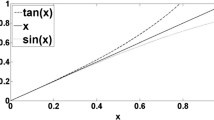Abstract
Using computer graphics and visualization algorithms, we extend in this work the results obtained analytically in Danca et al. (Int. J. Bifurc. Chaos, 19:2123–2129, 2009), on the connectivity domains of alternated Julia sets, defined by switching the dynamics of two quadratic Julia sets. As proved in Danca et al. (Int. J. Bifurc. Chaos, 19:2123–2129, 2009), the alternated Julia sets exhibit, as for polynomials of degree greater than two, the disconnectivity property in addition to the known dichotomy property (connectedness and totally disconnectedness), which characterizes the standard Julia sets. Via experimental mathematics, we unveil these connectivity domains, which are four-dimensional fractals. The computer graphics results show here, without substituting the proof but serving as a research guide, that for the alternated Julia sets, the Mandelbrot set consists of the set of all parameter values, for which each alternated Julia set is not only connected, but also disconnected.







Similar content being viewed by others
Notes
Intuitively, a totally disconnected set is a set, which can be broken into two pieces at each of its points, the breakpoint being always “in between” the original set while if a set can be separated into two open and disjoint sets such that neither set is empty and both sets combined give the original set, then the set is called disconnected. A set which is not disconnected is connected.
References
Danca, M.-F., Romera, M., Pastor, G.: Alternated Julia sets and connectivity properties. Int. J. Bifurc. Chaos 19, 2123–2129 (2009)
Almeida, J., Peralta-Salas, D., Romera, M.: Can two chaotic systems give rise to order? Physica D 200, 124–132 (2005)
Romera, M., Small, M., Danca, M.-F.: Deterministic and random synthesis of discrete chaos. Appl. Math. Comput. 192, 283–297 (2007)
Danca, M.-F., Romera, M., Pastor, G., Montoya, F.: Finding attractors of continuous-time systems by parameter switching. Nonlinear Dyn. 67, 2317–2342 (2012)
Peitgen, H.-O., Saupe, D.: The Science of Fractal Images, p. 198. Springer, New York (1988)
Mandelbrot, B.B.: The Fractal Geometry of Nature. Freeman, New York (1977)
Fatou, P.: Bull. Sur les équations fonctionnelles. Bull. Soc. Math. Fr. 47, 161–271 (1919). Also in Bull. Soc. Math. Fr. 48, 33–94, 208–314 (1920)
Julia, G.: FrMémoire sur l’itération des fonctions rationnelles. J. Math. Pures Appl. 8, 47–245 (1918)
Blanchard, P., Devaney, R., Keen, L.: Complex dynamics and symbolic dynamics. In: Williams, S.G. (ed.) Symbolic Dynamics and Its Applications. Proc. Symp. Appl. Math., vol. 60, pp. 37–60 (2004)
Branner, B., Hubbard, J.H.: Iteration of cubic polynomials. Part I: The global topology of parameter space. Acta Math. 160, 143–206 (1988)
Branner, B., Hubbard, J.H.: Iteration of cubic polynomials. Part II: Patterns and parapatterns. Acta Math. 169, 229 (1992)
Blanchard, P.: Disconnected Julia sets. In: Barnsley, M., Demko, S. (eds.) Chaotic Dynamics and Fractals, pp. 181–201. Academic Press, San Diego (1986)
Qiu, W., Yin, Y.: Proof of the Branner–Hubbard conjecture on Cantor Julia sets. Sci. China Ser. A 52, 45–65 (2009)
Altmann, S.L.: Rotations, Quaternions, and Double Groups. Clarendon Press, Oxford (1986)
Drebin, R.A., Carpenter, L., Hanrahan, P.: Volume rendering. In: Proceedings of the 15th Annual Conference on Computer Graphics and Interactive Techniques (SIGGRAPH’88), vol. 22, pp. 65–74. ACM, New York (1988)
Limaye, A.: Drishti: a volume exploration and presentation tool. In: Proceedings SPIE 8506, Developments in X-Ray Tomography VIII, 85060X (2012). http://proceedings.spiedigitallibrary.org/proceeding.aspx?articleid=1384273
Acknowledgements
We thank Robert L. Devaney and Bodil Branner for their useful comments, which helped us to understand better the connectivity aspects presented in [1].
We thank the reviewers for their valuable comments, which helped to considerably improve the quality of the manuscript.
The work was supported by iVEC through the use of advanced computing resources located at the University of Western Australia. The volume rendering is performed using Drishti, a “Volume Exploration and Presentation Tool” developed by Ajay Limaye at the Australia National University [16].
Author information
Authors and Affiliations
Corresponding author
Rights and permissions
About this article
Cite this article
Danca, MF., Bourke, P. & Romera, M. Graphical exploration of the connectivity sets of alternated Julia sets. Nonlinear Dyn 73, 1155–1163 (2013). https://doi.org/10.1007/s11071-013-0859-y
Received:
Accepted:
Published:
Issue Date:
DOI: https://doi.org/10.1007/s11071-013-0859-y




